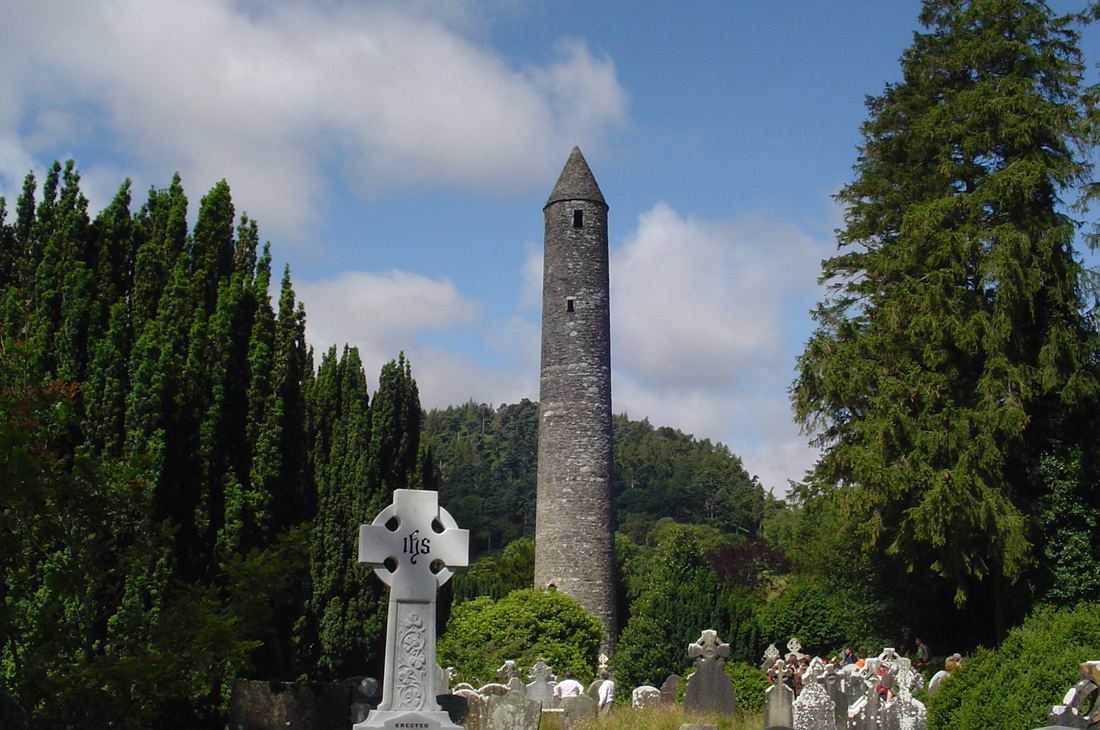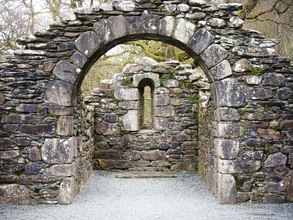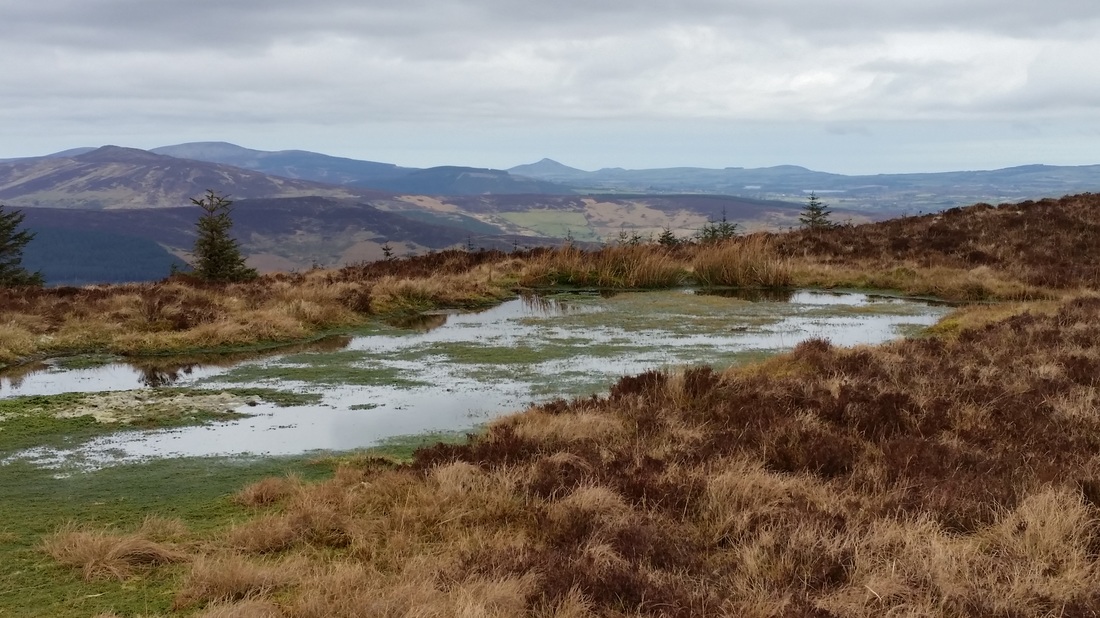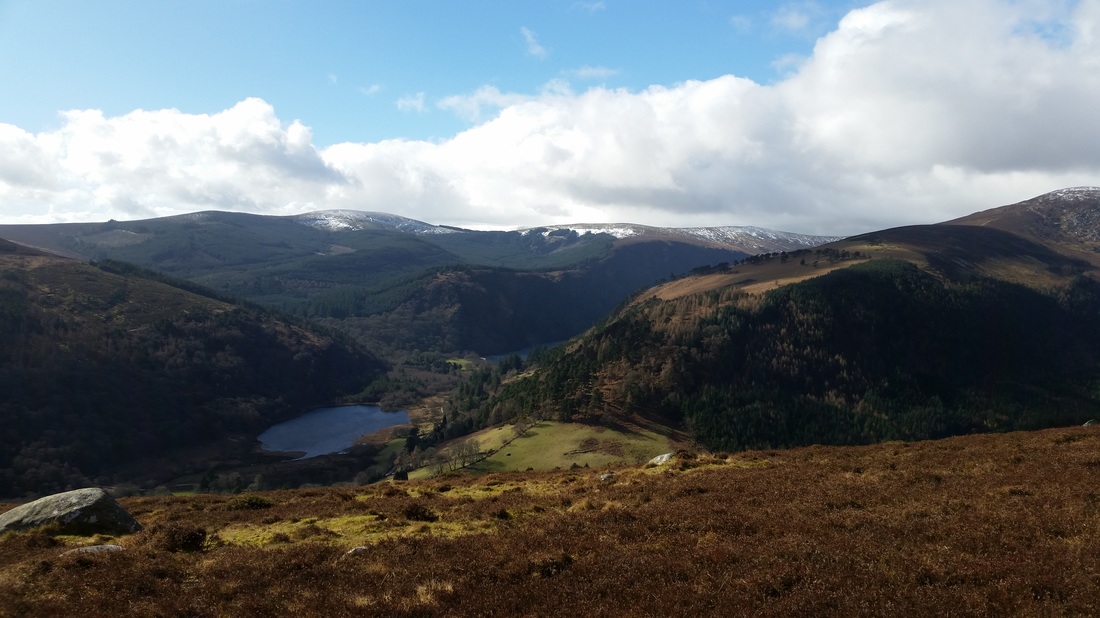Storms were on the horizon, with thunder and lightning having been reported in nearby Galway, so the priest began by saying he “would not test the Lord” but would move the service along quickly. Indeed, the sky first lightened a bit with the dawn but then darkened, and as a pelting rain let loose the abbey sprang a new and colorful ceiling, with umbrellas plentiful enough to keep the congregation dry.
Outdoor Easter dawn Masses are common in Ireland, especially in the west. The tradition reminded me of the continuity of nature spirituality that linked early Celtic Christian beliefs to pre-Christian Celtic forbears.
The Celts, of course, were not the first peoples of Ireland. People began arriving in Ireland at the end of the last Ice Age, much the same as in our own Driftless Region. As with most indigenous peoples, nature was central to their spirituality. Neolithic Irishmen built temples cum tombs cum observatories to mark the solstices and equinoxes, possibly linking the practical knowledge of the skies (important to agriculture) to rituals for the dead.
When Celtic culture arrived around 500 B.C.—likely by migration and osmosis, not by invasion as the Celtic mythologies would claim—the landscape continued to be viewed as spiritual. Amergin, the first Celtic poet according legend, chants the words of the creator-god:
I am the wind which breathes upon the sea
I am the ocean wave,…
I am a sunbeam,
I am the fairest of plants,
I am a wild boar in valour,
I am a salmon in the water,
I am a lake in the plain,…
I am the God who lights fire in the brain.
Who is it who throws light into the meeting on the mountain?
Who announces the ages of the moon?
Who teaches the place where the sun makes his bed?
Water, special stones, certain animals, and oak trees were just a few of nature’s key spiritual elements for pre-Christian Celts. This is not surprising for a rural culture that did not develop cities, as did continental Europe, especially as the latter came under the influence of the Roman Empire.
But the Romans never conquered Ireland, never attempted to, and even as Christianity came to Ireland (shortly after the withdrawal of the Roman Empire from Britain), the Celtic Christian church retained the rural reverence for nature held by the pre-Christian Celts in ways that the continental Christian Church did not. Indeed, for the continental Church, even the word for a non-Christian belied the Church’s bias toward the city: the word “pagan” derives from a word meaning a “country person.”
Holy wells of the pre-Christians continued as holy wells dedicated to saints. Sacred stones of the pre-Christian Celts were incorporated into medieval monastic abbeys. Animals reverenced by the pre-Christian Celts retained their importance to the Christian Celts. (One need only to hear the legend of St. Kevin, nursing in his outstretched hand a bird’s egg laid there as he prayed.) The oak retained its importance for the Celtic Christians: the name Killdare, for example, means simply the “church [cill] by the oak [dara].” Even certain saints like Brigit demonstrated a continuity with the past: Brigit the goddess had been a patron of poets, St. Brigit a patron of the arts.
This Celtic Christian Church was notably different from the Romanized Church, but was not consciously in rebellion—the Reformation was still more than a millennium away. Rather, the world was a large place in the fourth century, and communication slow and difficult. Local differences among Christian communities were to be expected. But the lack of cities in Ireland reduced the influence of city-loving and uniformity-inducing bishops. Instead, local monastery abbots held more influence than bishops, and the Irish church went on its merry individual way.
This would change in steps and stages over the centuries. The Irish church finally gave in on such matters as recognizing Rome’s date for Easter, how to wear monastic tonsures (Irish monks shaved the front half of their heads bald instead of the more iconic continental monk’s top bald spot!). The Anglo-Norman invasion/osmosis brought the ascendancy of bishops and continental monastic orders. The English Protestant Reformation and Penal Laws drove the Irish Catholic Church underground—and in some ways back to nature by necessity, with outdoor Masses at Mass Rocks. But at the same time, religious oppression drove the Irish to embrace the Romanized Church as an act of resistance against the British. Slowly the Celtic belief in the goodness of nature was replaced by Roman denigration of the body, denigration of the physical universe.
But an indigenous spirituality always operated alongside the traditional church in Ireland—walking in pilgrimages, circling in bonfire walks, worshipping at holy wells, tying trinkets to prayer trees. All of these had their roots in pre-Christianity, and the institutional church gave a nervous, begrudging approval or looked the other way.
The spirituality of nature has been continuous in Ireland through migrations and intermingling of different peoples, through introduction of new religions such as Celtic Druidism and Celtic Christianity, and through invasions and external threats in ways that did not happen in our own country. ]In contrast, American culture lacks this continuous, ongoing link to the landscape due to a self-inflicted disconnect dating to Native Americans being forced from the land. As a result, their stories and spiritualties are largely lost to the rest of us. (The British, it might be said, attempted to the do the same in Ireland, but didn’t fully succeed.)
Connections, or disconnections, to the present are more complicated? As Ireland becomes increasingly urbanized, modernized, and globalized, the link of people to place is wearing thin, especially among the younger generations.
But the implosion of institutional religion—the Catholic Church’s abuse scandals in Ireland, for example, were even more egregious than in our own, and the Church has paid a heavy price as a result—has left an opening for nature spirituality to re-emerge. A revival of interest in Celtic sensibilities infused with strands of Hinduism, Buddhism, and various personal flavorings is helping to re-establish the link of people to landscape.
Perhaps Laudato Si will put the institutional Church back into the conversation as well.
The rain let up as the Easter Dawn Mass came to end, and we all closed our umbrellas, gave our thank-you’s to the priest who had served us through the downpour, and ducked down to exit the ruins. Clew Bay was at high tide, and several of us paused at the shore to watch small waves gather in the breeze. To the west, Croagh Patrick loomed, its peak just barely visible in the squall still emptying on the mountain.
This is an old, old land, I realized, but no older than my own in the Driftless region. Earth land has stories. That’s what makes it spiritual to believers and nonbelievers alike. The deeper the stories—geological, religious, historical, personal—the more spiritual it is.
But people can lose connection with the land. It may happen through genocide, through which an indigenous people’s stories are lost. It may happen through modernization, which offers a false impression that we can with impunity trade physical places for virtual ones.. Even modern ecology can ironically dissociate us from spiritual landscapes if there is no room to consider the stories of the land.
Even so, about a hundred people had gathered in the dark at Morrisk Abbey even with the threat of immanent rain on Easter morning. They could have slept in, gone to church some place with a roof and heat, or ignored the ancient feast altogether.
Somehow I think those gathered did so to keep alive the stories of that place.
That is a spiritual event.




